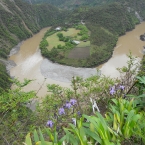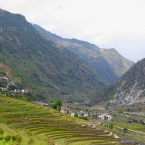China's Nu River Hangs in the Balance, Part 1
This is part one of a three-part blog describing my recent trip to the Nu River valley in April 2011. All names have been changed to protect the identity of the interviewees. Part 2 introduces the voices from the ground and Part 3 discusses the Nu River's future.
As a Chinese American growing up in the US, I saw China's mountains, rivers and valleys through my mom's traditional scroll paintings. Idyllic villages and small cottages dot green mountainsides of bamboo, pine, and palm.
My recent journey to the Nu River valley, also known as the Nujiang da xiagu ("Nu River Grand Canyon"), was nothing like stepping into one of these paintings.
Instead, my fellow travelers from a local Chinese NGO and I plunged into a collage of old and new China: sprawling development, dust and debris, majestic snow-capped mountains and roaring waves, construction cranes and electric towers, poverty and luxury.
Most of all, in spite of being surrounded by the constant threat of landslides and the rapid pace of development, we saw the resilience of the local people and the landscape in which they lived. However, should a 13-dam cascade move forward, this fragile balance could easily be toppled, leading to the suffering and devastation of thousands.
The myth of the pristine
The Nu River valley has been called the Grand Canyon of the East, but it is nothing like the Grand Canyon that I know. While the mountaintops boast incredible biodiversity, human habitation stretches from mountain base to mountain top. Traditional and new state-built housing dot the river- and the mountain-sides, often just a few feet away from the debris of old and new landslides. From the predominately Lisu and Nu ethnic groups to the south, to the Tibetan communities in the north, over 300,000 people call the region home.
The Nu River has also been called the last free-flowing river in China. Not so. While the stretch of the river in Yunnan Province has been able to stay undammed, thanks in large part to domestic and international efforts in the past decade to stop the dam cascade, dam building has already commenced upstream of the Nu River in Tibet. In addition, over a hundred small and medium dams dot the Nu River's tributaries. These tributaries, not the mainstream, are what communities predominantly depend upon for water, food, and energy.
Since I held a foreign passport, we were not able to venture into Tibet to visit the northern-most dam in the cascade, site of Songta Dam. However, along the way, we documented evidence of site work at six of the 13 dams.
Last December, the Kunming-based environmental group Green Watershed, led by Goldman Prize winner Dr. Yu Xiaogang, accompanied two retired geologists to the Nu valley and were able to venture as far north as the Songta Dam site. There, they documented extensive roadwork, the partial rock filling of the river, and a line stretched across the steep and spectacular gorge where the future dam would be. News reports and independent accounts by river enthusiasts and kayakers have also indicated that as many as five other dams may be being built upstream in Tibet .
The clear result of this would not only mean the destruction of the scenic value of the Three Parallel Rivers World Heritage Site, which includes the Nu River, but also reduced environmental flows for all the communities living downstream both in Yunnan and across the border in Burma.
In addition, there is clear evidence of seismic risk in the region from both scientific research and the daily, lived experiences of the valley's inhabitants. (I stopped taking pictures of landslides after passing the nth one along our car ride). Despite this, the signal from Beijing is mixed. Huadian, the state-owned company planning to build the dams, has listed the Nu River as a hydropower zone to be developed by 2015. However, top government officials in Beijing and Yunnan have also stated that they will not proceed with the dams without extensive research.
Read Part 2, where community members describe their views of the dam projects.






